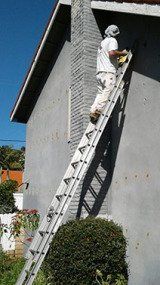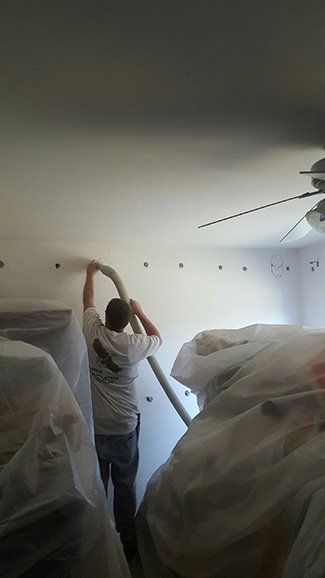When You Hire My Company, I Will Be Working On Your Home Personally
Cellulose Insulation
This is a loose fluffy gray material, which is blown through a hose into attics and walls. Eagle Insulation
uses cellulose.
Why cellulose? Because I have used almost every type of insulation in the industry and during my 20+ years of experience, I have found cellulose to be the best for insulating existing homes.
Thermolok cellulose insulation is made from recycled natural fibers combined with 100% boron, producing the greenest as well as the safest insulation on the market. Cellulose is non-toxic and non-irritating. Cellulose meets tough fire safety tests required by state regulations. You can even take a blow torch to Cellulose and it will turn black but not burn.
Cellulose provides a higher R Value per inch than fiberglass. R Value is a rating system used to compare resistance to heat flow. Comparatively, 8.1" = R-30 for cellulose up to 13" for a R-30 when using blown-in or laid-in fiberglass.
Performance Advantages of Cellulose:
- Improves indoor air quality - because it's made without formaldehyde.
- Thermally efficient - provides effective resistance to heat transfer.
- Controls sound - reduces transmission of sound through exterior and interior walls and floor/ceiling assemblies.
- Fire-resistant and noncombustible
- Noncorrosive - does not accelerate corrosion of pipes, wiring or metal studs.
- Mold-resistant - does not support mold or mildew. Does not supply a food source for insects or rodents.
- Flexible - forms readily around corners and curved surfaces.
There are various types of fiberglass batts:
Un-Faced fiberglass batts
have no paper, plastic or foil vapor barrier on them. This is the most common form of fiberglass. It is used in new construction homes and existing attics, where it is laid in place.
Kraft Faced fiberglass
has a paper vapor barrier facing on one side enabling it to be stapled in place.
A vapor barrier (or vapour barrier) is any material used for damp proofing, typically a plastic or foil sheet, that resists diffusion of moisture through wall, ceiling and floor assemblies of buildings.
FSK Foil Faced fiberglass batts
have a flame resistant facing on one side, so it can be stapled in place and not have to be covered by drywall. This is usually used in garages where the homeowner does not want to drywall after the insulation is installed.
Comfort Therm fiberglass batts are encapsulated in a thin plastic sack perforated with small holes on one side.
Fiberglass will melt but not burn. Fiberglass comes with a warning label on each package stating that it is a possible carcinogen. Fiberglass does cause irritations if the particles come in contact with the eyes or skin.



